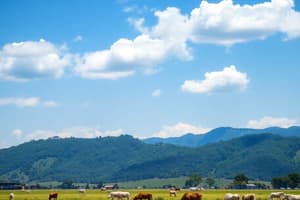Podcast
Questions and Answers
Which population distribution type describes a population with a high density in a small area, like a city?
Which population distribution type describes a population with a high density in a small area, like a city?
- Clustered (correct)
- Linear
- Scattered
- Urban
What is a characteristic of a population pyramid with a youthful population?
What is a characteristic of a population pyramid with a youthful population?
- The population is shrinking.
- A larger proportion of the population is over 60 years old.
- The base of the pyramid is wider than the top. (correct)
- There are more deaths than births.
Which of the following is NOT a consequence of an aging population?
Which of the following is NOT a consequence of an aging population?
- Increased need for pension and healthcare systems.
- Decreased workforce participation.
- Increased demand for education and childcare services. (correct)
- Increased strain on resources.
What is a likely impact of a youthful population on a country's economy?
What is a likely impact of a youthful population on a country's economy?
Which of the following is a characteristic of a population pyramid with a shrinking population?
Which of the following is a characteristic of a population pyramid with a shrinking population?
What is the primary focus of the Demographic Transition Model (DTM)?
What is the primary focus of the Demographic Transition Model (DTM)?
In a country with a youthful population, which of the following services is likely to have a higher demand?
In a country with a youthful population, which of the following services is likely to have a higher demand?
In the Demographic Transition Model (DTM), what generally happens to birth rates as a country experiences economic development?
In the Demographic Transition Model (DTM), what generally happens to birth rates as a country experiences economic development?
What does the term 'population density' refer to?
What does the term 'population density' refer to?
Which model of population growth describes populations that increase without limits?
Which model of population growth describes populations that increase without limits?
How is the doubling time of a population calculated using the rule of 70?
How is the doubling time of a population calculated using the rule of 70?
What characterizes logistic growth in a population?
What characterizes logistic growth in a population?
What is meant by 'net migration rate'?
What is meant by 'net migration rate'?
What can the natural increase rate (RNI) be determined by?
What can the natural increase rate (RNI) be determined by?
In the context of population growth, what does the term 'human settlement' refer to?
In the context of population growth, what does the term 'human settlement' refer to?
What does an accurate model of population dynamics aim to achieve?
What does an accurate model of population dynamics aim to achieve?
What defines a refugee?
What defines a refugee?
Which of the following factors is considered a push factor?
Which of the following factors is considered a push factor?
What is the minimum point score required to immigrate to Canada using the Point System?
What is the minimum point score required to immigrate to Canada using the Point System?
Which category best describes immigrants who can financially contribute to Canada’s economy upon arrival?
Which category best describes immigrants who can financially contribute to Canada’s economy upon arrival?
Which of the following statements about the Point System is true?
Which of the following statements about the Point System is true?
What does the term 'economic immigrants' include?
What does the term 'economic immigrants' include?
Which characteristic of immigrants is likely to earn fewer points in the Point System?
Which characteristic of immigrants is likely to earn fewer points in the Point System?
What is a common characteristic of the family class of immigrants in Canada?
What is a common characteristic of the family class of immigrants in Canada?
Flashcards
Population Density
Population Density
The number of people living in a specific area.
Human Settlement
Human Settlement
A place where people live.
Population Growth
Population Growth
The rate at which a population is growing.
Birth Rate
Birth Rate
Signup and view all the flashcards
Death Rate
Death Rate
Signup and view all the flashcards
Natural Increase Rate
Natural Increase Rate
Signup and view all the flashcards
Net Migration Rate
Net Migration Rate
Signup and view all the flashcards
Doubling Time
Doubling Time
Signup and view all the flashcards
Scattered Population
Scattered Population
Signup and view all the flashcards
Clustered Population
Clustered Population
Signup and view all the flashcards
Linear Population
Linear Population
Signup and view all the flashcards
Dependency Load
Dependency Load
Signup and view all the flashcards
Urbanization
Urbanization
Signup and view all the flashcards
Counter-Urbanization
Counter-Urbanization
Signup and view all the flashcards
Growing Population Pyramid
Growing Population Pyramid
Signup and view all the flashcards
Stagnant Population Pyramid
Stagnant Population Pyramid
Signup and view all the flashcards
Refugee
Refugee
Signup and view all the flashcards
Immigrant
Immigrant
Signup and view all the flashcards
Emigrant
Emigrant
Signup and view all the flashcards
Family Class Immigration
Family Class Immigration
Signup and view all the flashcards
Economic Immigrants
Economic Immigrants
Signup and view all the flashcards
Push Factor
Push Factor
Signup and view all the flashcards
Pull Factor
Pull Factor
Signup and view all the flashcards
Canadian Points System
Canadian Points System
Signup and view all the flashcards
Youthful population pyramid
Youthful population pyramid
Signup and view all the flashcards
Aging population pyramid
Aging population pyramid
Signup and view all the flashcards
High dependency ratio
High dependency ratio
Signup and view all the flashcards
Demographic Transition Model (DTM)
Demographic Transition Model (DTM)
Signup and view all the flashcards
Stage 1 of DTM: High Stationary
Stage 1 of DTM: High Stationary
Signup and view all the flashcards
Stage 2 of DTM: Early Expanding
Stage 2 of DTM: Early Expanding
Signup and view all the flashcards
Stage 3 of DTM: Late Expanding
Stage 3 of DTM: Late Expanding
Signup and view all the flashcards
Stage 4 of DTM: Low Stationary
Stage 4 of DTM: Low Stationary
Signup and view all the flashcards
Study Notes
Human Populations Unit Test Review
- Unit 2 Test scheduled for Tuesday, April 16, 2025
- Use the provided checklist and diagrams for studying.
Population Density
- Population density is the number of people living in a specific area.
- Human settlements are places where people live.
- Population density formula: Population / Area (People per km²)
Population Growth
- Population ecologists use various models to predict population changes.
- Two basic models are:
- Exponential growth: Population increases without limits.
- Logistic growth: Growth is limited by resources.
- Population growth is calculated as (Births - Deaths) + (Immigration - Emigration).
- The Rule of 70 is a calculation to determine doubling time for an investment. It's calculated by dividing 70 by the growth rate.
Population Distribution
- Types of population distribution include:
- Scattered: Few people spread over a large area.
- Clustered: Many people live in a small area.
- Linear: Distribution along a line.
- Census metropolitan area (CMA): Urban area with at least 100,000 people.
- Canadian population settlement patterns: Majority live in the southern part near the US border
- Factors influencing population distribution include: climate, natural resources, and transportation.
Urbanization and Counter-Urbanization
- Urbanization is the move from rural areas to urban.
- Reasons people move to urban areas: reduced farm labor needs, improved mobility, and consolidated goods & services.
- Counter-urbanization: Movement from urban to rural areas.
- Reasons for this include: affordability and lack of overcrowding.
Population Pyramids
- Population pyramids visually represent population structure.
- Growing population: Wide base (young people) more young people.
- Stagnant population: Approximately equal number of younger and older people.
- Shrinking population: Narrow base (fewer young people) less young people.
- Dependency load (ratio): Percentage of population not working reliant on others
Immigration and Refugees
- Immigrants: People moving to another country permanently.
- Refugees: Individuals fleeing persecution or danger in their home country.
- Reasons for immigration to Canada include: family, economic opportunities, political asylum and humanitarian or compassionate reasons.
Studying That Suits You
Use AI to generate personalized quizzes and flashcards to suit your learning preferences.
Related Documents
Description
Prepare for the upcoming Unit 2 Test on Human Populations by reviewing key concepts such as population density, growth models, and distribution patterns. Use the provided checklist and diagrams to enhance your study sessions and ensure you're ready for April 16, 2025.




